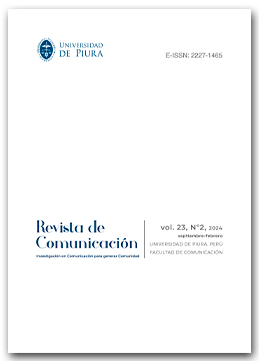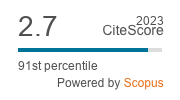Instagram como canal promocional de moda de lujo. Estudio de los desfiles como herramientas de comunicación
DOI:
https://doi.org/10.26441/RC23.2-2024-3583Palabras clave:
moda de lujo, Instagram, influencers, identidad de marca, comunicacion corporativa, historia de marcaResumen
Las marcas de moda de lujo emplean Instagram como canal de difusión de sus identidades corporativas, cubriendo nichos de mercado a los que antes no llegaban por su carácter exclusivo, mediante la publicación de contenido sobre eventos propios, como las pasarelas. Los desfiles se han convertido en instrumentos de branding. Sin embargo, la literatura previa se centra en las colaboraciones de estas marcas con influencers, sin otorgar el protagonismo principal al emisor primario del discurso organizacional. ¿Qué formatos se emplean más? ¿Con qué intención? ¿Cómo se relaciona la firma con el influencer en el perfil corporativo? ¿Qué tipo de contenido genera un mayor impacto en la audiencia?
Para responder a esas preguntas de investigación, este trabajo parte del objetivo principal de comparar cómo las firmas de moda de lujo con más seguidores emplean Instagram para transmitir su identidad de marca mediante la promoción de sus desfiles.
Se plantea un análisis de contenido mixto, cuantitativo y cualitativo, de los 387 posts publicados por Dior, Chanel, Dolce & Gabbana, Louis Vuitton y Gucci entre el 10 de febrero y el 7 de marzo de 2023, cuando se celebran las semanas de la moda de París, Milán, Nueva York y Londres.
El análisis revela una relación no proporcional entre la frecuencia de publicación, las interacciones registradas y el porcentaje de engagement, siendo mayor este último cuando el formato empleado es la imagen participada por un influencer. Asimismo, la intención discursiva es eminentemente comercial, con protagonismo de productos concretos incluso cuando se comparten historias de marca.
Métricas
Citas
Alameda, D., Fernández-Blanco, E. y Hernández, S. (2023). Branding and Marketing Communication in the Field of Wine: The Experiences of Spanish Denominations of Origin to Build Brand Territory. Tripodos, 54. https://doi.org/10.51698/tripodos.2023.54.05 DOI: https://doi.org/10.51698/tripodos.2023.54.05
Alonso González, M. (2015). Las redes sociales como canal de comunicación de las marcas de moda españolas: el caso de Zara, Mango y El Corte Inglés (Social Media as communication channels for fashion brands in Spain: the cases of Zara, Mango and El Corte Inglés). Index.comunicación: Revista Científica en el Ámbito de la Comunicación Aplicada, 5(1), 77-105. https://dialnet.unirioja.es/servlet/articulo?codigo=5277295
Athwal, N., Istanbulluoglu, D. & McCormack, S. (2019). The allure of luxury brands’ social media activities: a used and gratifications perspective. Information Technology & People, 32(3), 603-626. https://doi.org/10.1108/ITP-01-2018-0017 DOI: https://doi.org/10.1108/ITP-01-2018-0017
Beauchamp, M. B. & Barnes, D. C. (2015). Delighting Baby Boomers and Millennials: Factors that matter most. Journal of Marketing Theory and Practice, 23(3), 338-350. https://doi.org/10.1080/10696679.2015.1032472 DOI: https://doi.org/10.1080/10696679.2015.1032472
Boerman, S.C. (2019). The effects of the standardized instagram disclosure for micro and meso-influencers. Computers in Human Behavior, 103, 199-207.https://doi.org/10.1016/j.chb.2019.09.015 DOI: https://doi.org/10.1016/j.chb.2019.09.015
Buitrago, S., Duque, P.L. & Robledo, S. (2020). Branding Corporativo: una revisión bibliográfica (Corporate Branding: a literature revisión). Económicas CUC, 41(1), 143-162. https://doi.org/10.17981/econcuc.41.1.2020.Org.1 DOI: https://doi.org/10.17981/econcuc.41.1.2020.Org.1
Campbell, C. & Farrell, J.R. (2020). More than meets the eye: the functional components underlying influencer marketing. Business Horizons, 63(4), 469-79. https://doi.org/10.1016/j.bushor.2020.03.003 DOI: https://doi.org/10.1016/j.bushor.2020.03.003
Capriotti, P. (2010). Branding corporativo. Gestión estratégica de la identidad corporativa (Corporate branding. Strategic management of the corporate identity). Revista Comunicación, 27, 15-22. https://dialnet.unirioja.es/servlet/articulo?codigo=5466032
Caro Castaño, L. (2015). Relaciones e Interacciones Parasociales En Redes Sociales Digitales (Relationships and parasocial interactions on social media). Una Revisión Conceptual. Revista ICONO 14, 13 (2), 23-47. https://doi.org/10.7195/ri14.v13i2.853 DOI: https://doi.org/10.7195/ri14.v13i2.853
Caro Castaño, L., Marín Dueñas, P.P. & García Osorio, J. (2024). La narrativa del político-influencer y su fandom. El caso de Isabel Díaz Ayuso y los ayusers en Instagram (Politician-Influencer narrative and its fandom. The Isabel Díaz Ayuso and the ayusers case on Instagram). Revista Mediterránea, 15(1). https://www.mediterranea-comunicacion.org/article/view/25339 DOI: https://doi.org/10.14198/MEDCOM.25339
Carcavilla Puey, F., & Aguirre Jiménez, A. I. (2022). La comunicación de la identidad de la marca Gucci en su perfil de Instagram (Communication of Gucci’s brand identity on Instagram). Doxa Comunicación, 34, 177-200. https://doi.org/10.31921/doxacom.n34a847 DOI: https://doi.org/10.31921/doxacom.n34a847
Carpenter, J.P., Morrison, S.A., Craft, M. & Lee, M. (2020). How and why are educators using Instagram? Teaching and Teacher Education, 96, 1-14. https://doi.org/10.1016/j.tate.2020.103149 DOI: https://doi.org/10.1016/j.tate.2020.103149
Casado-Riera, C., & Carbonel, X., (2018). La influencia de la personalidad en el uso de Instagram (The influence of the personality on Instagram use). Aloma. Revista de Psicologia, Ciències de l’Eduació i del’Esport, 36(2), 23-31.https://doi.org/10.51698/aloma.2018.36.2.23-31 DOI: https://doi.org/10.51698/aloma.2018.36.2.23-31
Chung, S. & Cho, H. (2017). Fostering parasocial relationships with celebrities on social media: Implications for celebrity endorsement. Psychology & Marketing, 34(4), 481-495. https://doi.org/10.1002/mar.21001 DOI: https://doi.org/10.1002/mar.21001
Creevey, D., Coughlan, J. & O’Connor, C. (2021). Social media and luxury: a systematic literature review. International Journal of Management Reviews, 24(1), 99-129. https://doi.org/10.1111/ijmr.12271 DOI: https://doi.org/10.1111/ijmr.12271
Dessart, L. (2017). Social media engagement: a model of antecedents and relational outcomes. Journal of Marketing Management, 33(5/6), 375-399. https://doi.org/10.1080/0267257X.2017.1302975 DOI: https://doi.org/10.1080/0267257X.2017.1302975
Djafarova, E. & Bowes, T. (2021). ‘Instagram made me buy it’: Generation Z impulse purchases in the fashion industry. Journal of Retailing and Consumer Services, 59.https://doi.org/10.1016/j.jretconser.2020.102345 DOI: https://doi.org/10.1016/j.jretconser.2020.102345
Dunkley, L. (2017). Reaching Generation Z: Harnessing the Power of Digital Influencers in Film Publicity. Journal of Promotional Communications, 5(1), 31-39. https://promotionalcommunications.org/index.php/pc/article/view/85
Estévez-Martín, A., Izquierdo-González, V., & Soler-Guirao, B. (2019). La moda de lujo en las redes sociales: Análisis del uso de Instagram por parte de la marca de moda de lujo Loewe (Luxury fashion on social media: analysis of Loewe’s use of Instagram). Creatividad y Sociedad, 31, 142-179. https://bit.ly/3XW7nNv
Ferrer González, L. J. (2018). Comportamiento del consumidor 2.0: nuevas realidades en entornos digitales (Behavior of consumer 2.0: new realities in digital environments). Marketing Visionario, 7(1), 141-155. http://ojs.urbe.edu/index.php/market/article/view/2727
García, V., Berrocal-Gonzalo, S. & D’Adamo, O. (2020). Atributos de liderazgo en Instagram durante las elecciones presidenciales en Argentina 2019 (Leadership attributes on Instagram during the 2019 presidential elections in Argentina). Index Comunicación, 10(1), 173-194. https://doi.org/10.33732/ixc/10/01Atribu DOI: https://doi.org/10.33732/ixc/10/01Atribu
García Medina, I., Miquel-Segarra, S., & Navarro-Beltrá, M. (2018). El uso de Twitter en las marcas de moda. Marcas de lujo frente a marcas low-cost (The use of Twitter in fashion brands. Luxury brands versus low-cost brands). Cuadernos.info, 42, 55-70. https://doi.org/10.7764/cdi.42.1349 DOI: https://doi.org/10.7764/cdi.42.1349
Gil-Quintana, J., & Fernández-Galiano, M. (2020). Publicaciones, interacciones, verdades y mentiras de adolescentes españoles en Instagram (Publications, interactions, truths and lies of Spanish teenagers on Instagram). Texto Livre Linguagem E Tecnologia, 13(1), 20–44. https://doi.org/10.17851/1983-3652.13.1.20-44 DOI: https://doi.org/10.17851/1983-3652.13.1.20-44
Glanfield, K., Ackfeldt, A.L. & Melewar, T.C. (2018). Corporate branding’s influence on front-line employee and consumer value co-creation in UK household consumer markets. Journal of General Management, 43(2), 63-69. https://doi.org/10.1177/0306307017740184 DOI: https://doi.org/10.1177/0306307017740184
Góngora Díaz, G. & Lavilla Muñoz, D. J. (2020). La importancia de la construcción de marca en Instagram para las empresas periodísticas (The importance of brand building on Instagram for journalism companies). En Figuereo Benítez, J. C. (Ed.), Estudios multidisciplinarios en comunicación audiovisual, interactividad y marca en la red (pp. 129). Egregius.
Habibi, M., Laroche, M. & Richard, M. (2014). The roles of brand community and community engagement in building brand trust on social media. Computers in Human Behavior, 37, 152-161. https://doi.org/10.1016/j.chb.2014.04.016 DOI: https://doi.org/10.1016/j.chb.2014.04.016
Hazari, S. & Sethna, B. (2023). A comparison of lifestyle marketing and brand influencer advertising for Generation Z Instagram users. Journal of Promotion Management, 29(4), 491-534. https://doi.org/10.1080/10496491.2022.2163033 DOI: https://doi.org/10.1080/10496491.2022.2163033
He, Y., Ma, J. & Zhang, P. (2023). Perceived authenticity of hallmark event brands: conceptualizacion, measurement, and an integrative framework. Journal of Destination Marketing & Management, 27. https://doi.org/10.1016/j.jdmm.2023.100766 DOI: https://doi.org/10.1016/j.jdmm.2023.100766
Hernández, H., Muñoz, D. & Barrios, I. (2017). Estilos gerenciales y su influencia en la generación de valor de las Instituciones Prestadoras de Salud de la Región Caribe (Management styles and their influence on the generation of value of Health Providing Institutions in the Caribbean Region). Económicas CUC, 38(1), 133-146. https://doi.org/10.17981/econcuc.38.1.06 DOI: https://doi.org/10.17981/econcuc.38.1.06
Hollebeek, L. D., Glynn, M.S. & Brodie, R.J. (2014). Consumer Brand Engagement in Social Media: Conceptualization, Scale Development and Validation. Journal of Interactive Marketing, 28(2), 149-165. https://doi.org/10.1016/jintmar.2013.12.002 DOI: https://doi.org/10.1016/j.intmar.2013.12.002
Hootsuite. (2023). Calcula la tasa de interacción (Calculate the interaction rate). Hootsuite. https://bit.ly/3VVuaXa
Hudders, L., De Jans, S. & De Veirman, M. (2021). The commercialization of social media stars: a literatura review and conceptual framework on the strategic use of social media influencers. International Journal of Advertising, 40(3), 327-375. https://doi.org/10.1080/02650487.2020.1836925 DOI: https://doi.org/10.1080/02650487.2020.1836925
Jaime, A., Aguado, S. & García, F. (2022). Influencia de las variables de rendimiento del servicio y variables de marca en la lealtad de los usuarios de eventos de esports (Influence of service performance variables and brand variables on user loyalty of esports events). Retos: nuevas tendencias en educación física, deporte y recreación, 45, 860-867. https://dialnet.unirioja.es/servlet/articulo?codigo=8413112 DOI: https://doi.org/10.47197/retos.v45i0.93521
Jin, V., Muqaddam, A. & Ryu, E. (2019). Instafamous and social media influencer marketing. Marketing Intelligence & Planning, 37(5), 567-579. https://doi.org/10.1108/MIP-09-2018-0375 DOI: https://doi.org/10.1108/MIP-09-2018-0375
Jin, V. & Ryu, E. (2019). Instagram fashionistas, luxury visual image strategies and vanity. Journal of Product & Brand Management, 29(3), 355-368. https://doi.org/10.1108/JPBM-08-2018-1987 DOI: https://doi.org/10.1108/JPBM-08-2018-1987
Kadi, O. & Acevedo, A. (2014). Liderazgo ético frente a la diversidad cultural dentro de las organizaciones en régimen disciplinario (Ethical leadership in the face of cultural diversity within organizations under a disciplinary regime). Económicas CUC, 35(2), 75-88. https://revistascientificas.cuc.edu.co/economicascuc/article/view/522
Kahn, S. (2018). Instagram as a marketing tool for luxury brands. International Journal of Business and Management, 8(2), 120-126. https://www.researchgate.net/publication/329686602_Instagram_as_a_Marketing_Tool_for_Luxury_Brands
Kavaratzis, M. (2005). Place Branding: A review of trends and Conceptual Models. The Marketing Review, 5(4), 329-342. https://doi.org/10.1362/146934705775186854 DOI: https://doi.org/10.1362/146934705775186854
Kim, H. (2022). Keeping up with influencers: exploring the impact of social presence and para-social interactions on instagram. International Journal of Advertising, 41(3), 414-421. https://doi.org/10.1080/02650487.2021.1886477 DOI: https://doi.org/10.1080/02650487.2021.1886477
Li, G., Cao, Y., Lu, B., Yu, Y. & Liu, H. (2023). Luxury brands’ live streaming sales: the roles of streamer identity and level strategy. International Journal of Advertising, 42(7), 1178-1200. https://doi.org/10.1080/02650487.2023.2215075 DOI: https://doi.org/10.1080/02650487.2023.2215075
Lindholm J., Carlson T. & Högväg, J. (2021). See Me, Like Me! Exploring Viewers’ Visual Attention to and Trait Perceptions of Party Leaders on Instagram. The International Journal of Press/Politics. 26(1), 67-187. https://10.1177/1940161220937239 DOI: https://doi.org/10.1177/1940161220937239
Lou, C. & Yuan, S. (2018). Influencer marketing: how message value and credibility affect consumer trust of branded content on social media. Journal of Interactive Advertising, 19(1), 58-73. https://doi.org/10.1080/15252019.2018.1533501 DOI: https://doi.org/10.1080/15252019.2018.1533501
Martínez, E., Samacá, E., García, A. & Cifuentes, C. (2023). Generation Z in Chile, Colombia, México and Panama: Interests and new digital consumption habits. Their use of Instagram and TikTok. Profesional de la Información, 32(2). https://doi.org/10.3145/epi.2023.mar.18 DOI: https://doi.org/10.3145/epi.2023.mar.18
Martínez-Sala, A. M., Segarra-Saavedra, J. & Monserrat-Gauchi, J. (2018). Los millennials como prosumers y adprosumers en las redes sociales corporativas (Millennials as prosumers and adprosumers in corporate social networks). Cuadernos.info, 43, 137-159. https://doi.org/10.7764/cdi.43.1335 DOI: https://doi.org/10.7764/cdi.43.1335
Mattei, M.M. (2015). El divismo en tiempos de #Instagram (Divinity in times of #Instagram). CIC. Cuadernos de Información y Comunicación, 20, 95-107. https://www.redalyc.org/articulo.oa?id=935/93542537009 DOI: https://doi.org/10.5209/rev_CIYC.2015.v20.49385
Mendes, S. (2021). The Instagrammability of the Runway: Architecture, Scenography, and the Spatial Turn in Fashion Communications. Fashion Theory, 25(3), 311-338. https://doi.org/10.1080/1362704X.2019.1629758 DOI: https://doi.org/10.1080/1362704X.2019.1629758
Mendes, M., Baldissarelli, J.M., Machado, A., & Lucas, G. (2024). Estratégias de branding para a construção e consolidação de uma marca e a relação entre a percepção da marca e a intenção de compra. Revista Contribuciones a las Ciencias Sociales, 17(1), 1612-1635. https://doi.org/10.55905/revconv.17n.1-091 DOI: https://doi.org/10.55905/revconv.17n.1-091
Mingione, M. (2015). Inquiry into corporate brand alignment: a dialectical analysis and directions for future research. Journal of Product & Brand Management, 24(5), 518-536. https://doi.org/10.1108/JPBM-05-2014-0617 DOI: https://doi.org/10.1108/JPBM-05-2014-0617
Moreno, M. (2018). La enciclopedia del Community Manager (The Community Manager enciclopedia). Ediciones Deusto.
Pangarkar, A., Shukla, P. & Taylor, C. (2021). Minimalism in consumption: a typology and brand engagement strategies. Journal of Business Research, 127, 167-78. https://doi.org/10.1016/j.jbusres.2021.01.033 DOI: https://doi.org/10.1016/j.jbusres.2021.01.033
Oliveira, M. & Fernandes, T. (2020). Luxury brands and social media: drivers and outcomes of consumer engagement on Instagram. Journal of Strategic Marketing, 30(4), 389-407. https://doi.org/10.1080/0965254X.2020.1777459 DOI: https://doi.org/10.1080/0965254X.2020.1777459
Park, M., Im., H. & Kim, H. (2019). ‘You are too friendly!’ The negative effects of social media marketing on value perceptions of luxury fashion brands. Journal of Business Research. https://doi.org/10.1016/j.jbusres.2018.07.026 DOI: https://doi.org/10.1016/j.jbusres.2018.07.026
Pérez-Curiel, C., Sanz-Marcos, P. & Velasco Molpeceres, A. (2023). Performatividad de las identidades de género en moda. Impacto de los estereotipos en Vogue y GQ (Performativity of gender identities in fashion. Impact of stereotypes in Vogue and GQ). Cuadernos.info, 55, 71-92. https://doi.org/10.7764/cdi.55.52475 DOI: https://doi.org/10.7764/cdi.55.52475
Qian, J. & Park, J.S. (2021). Influencer-brand fit and brand dilution in China’s luxury market: the moderating role of self-concept clarity. Journal of Brand Management, 28, 199-220. https://doi.org/10.1057/s41262-020-00226-2 DOI: https://doi.org/10.1057/s41262-020-00226-2
Rodríguez, M. & Vázquez, I. (2024). TikTok, la nueva Plataforma social para las marcas de lujo. Visual Review, 16(3). https://doi.org/10.62161/revvisual.v16.5255 DOI: https://doi.org/10.62161/revvisual.v16.5255
Roux, E., Tafani, E. & Vigneron, F. (2017). Values associated with luxury brand consumption and the role of gender. Journal of Business Research, 71, 102-13. https://doi.org/10.1016/j.jbusres.2016.10.012 DOI: https://doi.org/10.1016/j.jbusres.2016.10.012
Sánchez, R. & Aparicio, P. (2020). Los hijos de Instagram. Marketing editorial. Poesía y construcción de nuevos lectores en la era digital (The children of Instagram. Editorial marketing. Poetry and construction of new readers in the digital age). Contextos Educativos. Revista de Educación, 41-53. http://doi.org/10.18172/con.4265 DOI: https://doi.org/10.18172/con.4265
Sanz Marcos, P., Pérez Curiel, C. & Velasco Molpeceres, A.M. (2020). Hacia un cambio en el sector de moda y lujo. Del dominio del influencer a la marca: Gucci, Loewe y Margiela (Towards a change in the fashion and luxury sector. From the domain of the influencer to the brand: Gucci, Loewe and Margiela). Revista de Comunicación, 19(2), 263-284. https://doi.org/10.26441/RC19.2-2020-A15 DOI: https://doi.org/10.26441/RC19.2-2020-A15
Segarra-Saavedra, J. & Hidalgo-Marí, T. (2020). Futbolistas en Instagram: análisis del marketing de influencia realizado por los capitanes de Primera División en España (Footballers on Instagram: analysis of influence marketing carried out by the captains of the First Division in Spain). Ámbitos. Revista Internacional De Comunicación, 48, 34–55. https://doi.org/10.12795/Ambitos.2020.i48.03 DOI: https://doi.org/10.12795/Ambitos.2020.i48.03
Shukla, P., Rosendo-Rios, V. & Khalifa, D. (2022). Is luxury democratization impactful? Its moderating effect between value perceptions and consumer purchase intentions. Journal of Business Research, 139, 782-93. https://doi.org/10.1016/j.jbusres.2021.10.030 DOI: https://doi.org/10.1016/j.jbusres.2021.10.030
Tafesse, W. & Wood, B.P. (2021). Followers' engagement with Instagram influencers: The role of influencers’ content and engagement strategy. Journal of Retailing and Consumer Services, 58. https://doi.org/10.1016/j.jretconser.2020.1023033 DOI: https://doi.org/10.1016/j.jretconser.2020.102303
Tarullo, R. & García, M. (2020). Hashtivismo feminista en Instagram: #NiñasNoMadres de @actrices.argentinas (Feminist hashtivism on Instagram: #NiñasNoMadres by @actrices.argentinas). Dígitos. Revista de Comunicación Digital, 6, 31-54. http://dx.doi.org/10.7203/rd.v1i6.172 DOI: https://doi.org/10.7203/rd.v1i6.172
Torregrosa, M., Sánchez-Blanco, C., San Miguel, P. & del Río Pérez, J. (2023). Instagram: Digital Behavior in Luxury Fashion Brands. En N. Sabatini, T. Sábada, A. Tosi, V. Neri & L. Cantoni (Eds.). Fashion Communication in the Digital Age. FACTUM 2023. Springer Proceedings in Business and Economics. Springer. https://.doi.org/10.1007/978-3-031-38541-4_2 DOI: https://doi.org/10.1007/978-3-031-38541-4_2
Üçok Hughes, M., Bendoni, W. K. & Pehlivan, E. (2016). Storygiving as a co-creation tool for luxury brands in the age of the internet: A love story by Tiffany and thousands of lovers. Journal of Product & Brand Management, 25(4), 357-364. http://doi.org/10.1108/JPBM-09-2015-0970 DOI: https://doi.org/10.1108/JPBM-09-2015-0970
Velar-Lera, M., Herrera-Damas, P. & González-Aldea, P. (2020). Uso de Instagram para la comunicación de las marcas de moda de lujo (Use of Instagram for communication by luxury fashion brands). Palabra Clave, 23(4), e2344. https://doi.org/10.5294/pacla.2020.23.4.4 DOI: https://doi.org/10.5294/pacla.2020.23.4.4
Velasco Molpeceres, A. (2021). Influencers, storytelling y emociones: marketing digital en el sector de las marcas de moda y el lujo (Influencers, storytelling and emotions: digital marketing in the fashion and luxury brand sector). Vivat Academia. Revista de Comunicación, 154, 1-18. https://doi.org/10.15178/va.2021.154.e1321 DOI: https://doi.org/10.15178/va.2021.154.e1321
Vicente-Fernández, P., Vinader-Segura, R., & Soria-Ibáñez, M.M. (2020). Redes sociales al servicio del marketing: análisis comparativo en el caso de Dulceida (Social networks at the service of marketing: comparative analysis in the case of Dulceida). Revista Espacios, 41(24), 342-358. https://bit.ly/4cAWKEo
Villafañe, J. (1999). La gestión profesional de la imagen corporativa (Professional management of the corporate image). Pirámide.
Vinerean, S. & Opreana, A. (2019). Social media marketing efforts of luxury brands on Instagram. Expert Journal of Marketing, 7(2), 144-152. http://hdl.handle.net/11159/4597
Vrontis, D., Makrides, A., Christofi, M. & Thrassou, A. (2021). Social media influencer marketing: A systematic review, integrative framework and future research agenda. International Journal of Consumer Studies, 45(4), 617-644. https://doi.org/10.1111/ijcs.12647 DOI: https://doi.org/10.1111/ijcs.12647
Wai, T., Ching, A., & Chiu, D. (2020). From Facebook to Instagram: Exploring user engagement in an academic library. The Journal of Academic Librarianship, 46(6). https://doi.org/10.1016/j.acalib.2020.102229 DOI: https://doi.org/10.1016/j.acalib.2020.102229
Publicado
Cómo citar
Número
Sección
Licencia
Derechos de autor 2024 Revista de Comunicación

Esta obra está bajo una licencia internacional Creative Commons Atribución-NoComercial-SinDerivadas 4.0.











 Portal de Revistas de la Universidad de Piura.
Portal de Revistas de la Universidad de Piura.